PIZZA DE RÉSISTANCE
Slow and sensual: Romancing the pizza, Durban-style
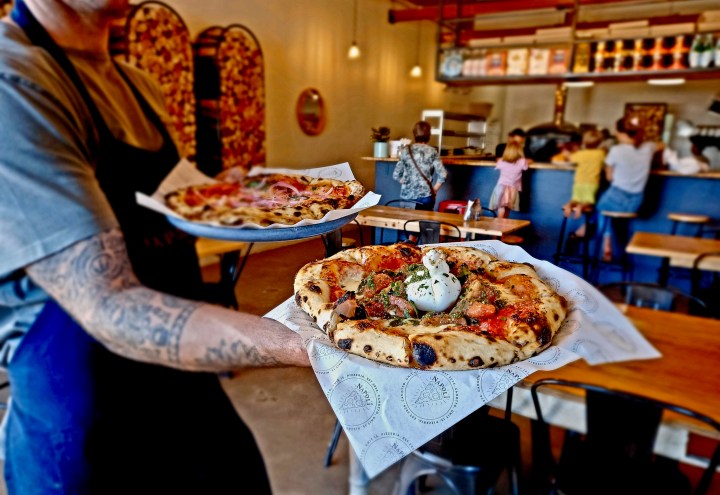
Are you a pizza lover or a pizzaphobe weirdough? What (or who) makes the difference? We talk pizza with Mark Mattinson at Napoli Fifteen in Hilton. And in Durban, Glenwood Bakery’s Adam Robinson and Pizza My Heart’s Kevin Fry.
Pizza. Fast food? How about when you have a Hilton-based pizzaiolo who spends 72 hours prepping each batch of dough? When each day, on starting the process, he consults a weather app, checks the anticipated humidity, and adjusts the water content for his canotto-style pizzas accordingly.
Then you hear that after a careful trial-and-error process, he gave up on the idea of using locally available flour and accepted he would have to import “the real thing” — three brands, from which he makes his own blend — from Italy. Along with the San Marzano tomatoes — these being key to the as-authentic-as-possible Italian-style pizzas, crispy with puffy, blistered, deliciously charred cornicione, which are his focus.
All this even before we get to the freshness, taste and creativity of what goes on top of each pizza, individually hand-stretched to order. The “gorgeous locally made soft cow’s milk cheeses we access”. Collaborations with a Midlands cheesemaker and with Kamberg charcutier, Franco Esposito. Products intentionally selected for flavour and quality, local where possible, and seasonal when things pop up, be they figs with pancetta or last week’s honey-poached pear with fired fennel and Gorgonzola.
Not surprising that chef turned pizzaiolo, Mark Mattinson, says “pizza need not be the fast food we grew up with, it can be slow food”. This is why he put up a sign that reads “good food, not fast food” three weeks after opening Napoli Fifteen — a week after my first visit, when I purchased two pizzas to take with me on a little road journey.
This drop-in was a kind of curiosity-courtesy check-in. I wrote about Mattinson when he was head chef, project manager, menu developer, kitchen staff trainer and mentor, etcetera, at the then-new Midlands Fable at Curry’s Post.
The story I wrote told of Mattinson’s food journey. How, when at a crossroads in his life a few years previously, he took a 900km walk, the full route of the Camino de Santiago, Saint-Jean-Pied-de-Port to Muxia. While walking, he fell in love with frittata, aka Spanish omelette aka tortilla de patatas. And came to the realisation that his true love, his interest, his passion, was food. This path he then followed: with stints in the UK, Europe, the Cape, the SA film industry and restaurants.
Read more in Daily Maverick: The taste of Fable in the KZN Midlands
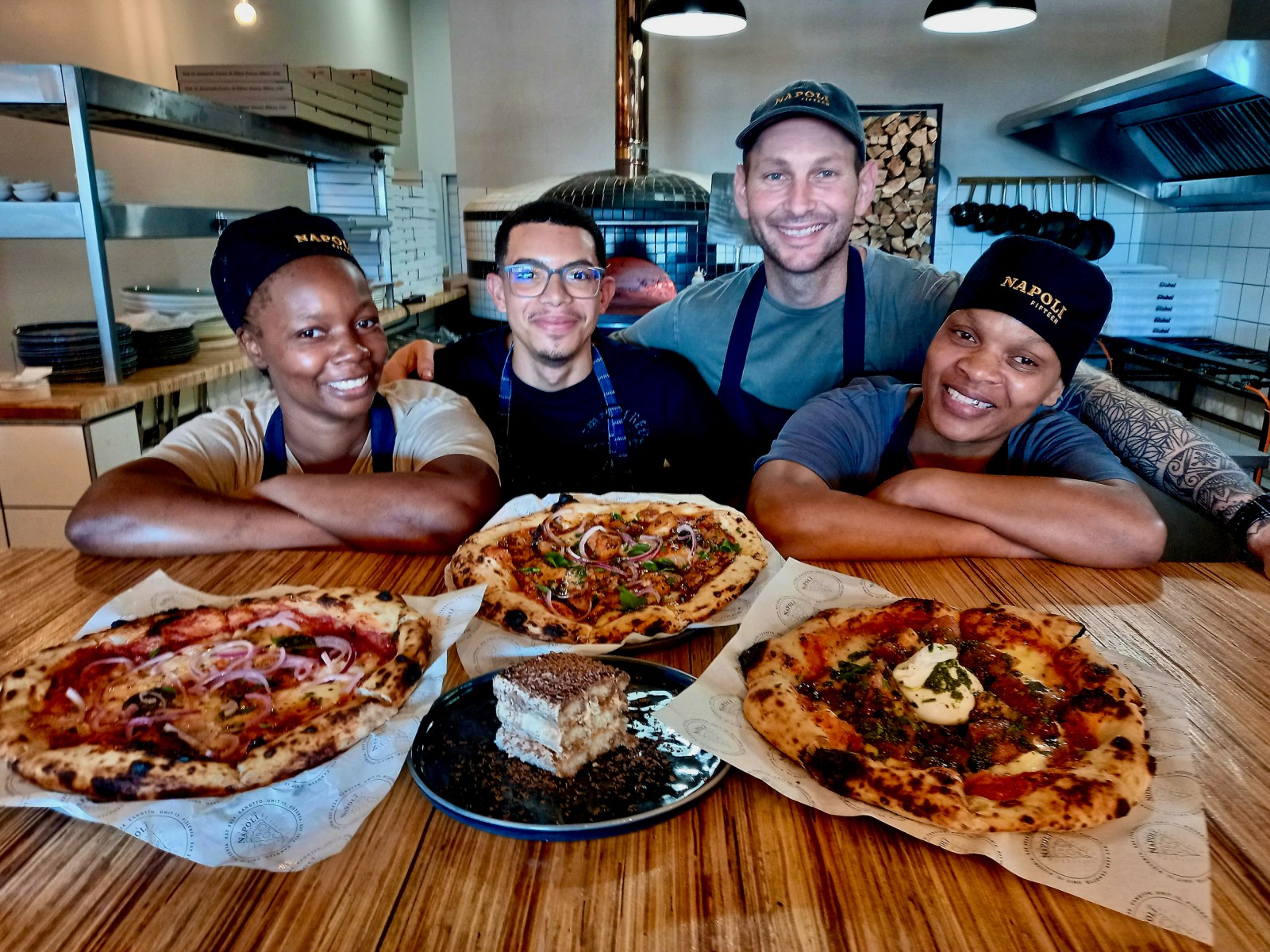
The Napoli Fifteen team: From left, Nomfundo Mbele, Jordan Plaatjes, Mark Mattinson and Pinky Mthembu with pizzas and a zabaglione tiramisu. Durban, 26 April 2024. (Photo: Wanda Hennig)
My two pizzas were an impulse purchase. A Pizza Truffle with “San Marzano tomatoes, coppa ham, (porto)bella mushrooms, fresh mozzarella, thyme and truffle oil…” And a Pizza Margherita with the same San Marzano tomatoes and mozzarella, then Parmesan, basil and extra virgin olive oil. For those interested, a good little read is this condensed version of the History of Pizza, the one-time peasant food’s ancient roots and how and for whom Neapolitan pizzaiolo Raffaele Esposito in 1889 created what became the Margherita, topped with tomatoes, mozzarella and basil representing the red, white and green of the Italian flag.
While both are Italian and both Esposito, Raffaele is not related to Midlands charcutier Franco, who makes odds-on the most authentic prosciutto, pancetta, salami, coppa, nduja — the artisanal slow-aged products on Mattinson’s pizzas, which are mainly from the pigs Esposito grows on the pristine and tranquil setting of his farm.
Read more in Daily Maverick: The bee-you-tee-ful charcuterie of Franco Esposito
Trawling the web for facts and figures, approximately 350 slices of pizza are eaten each second in the US, which has the largest pizza market, accounting for over one-third of worldwide pizza consumption. Italy bakes 2.7 billion pizzas a year and pizza is the culinary symbol of Italy for 89% of Italians, who place pizza just above pasta (88%) as best representing Italian cuisine, with wine at 59% and cappuccino at 51%. Here in SA, pizza is the third-largest fast-food category, making up 21% of the more than 5,000 fast-food stores in the country.
My knee-jerk is to think, I abhor pizzas. Memories of indigestible late-night-in-the-office stodgy, tasteless commercial pizzas eaten compulsively because they’re there. The thin-crust ones you order in chi-chi pizza joints, which even happened twice while I was researching this story. These are independent pizza joints. When you get what you ordered, while what’s on the top might be incinerated, the thin base is sometimes not cooked. Sometimes not even warm. And worse than these, if that is possible, pizzas with too much on top, whether good or bad in quality, creating a soggy indistinguishable mess.
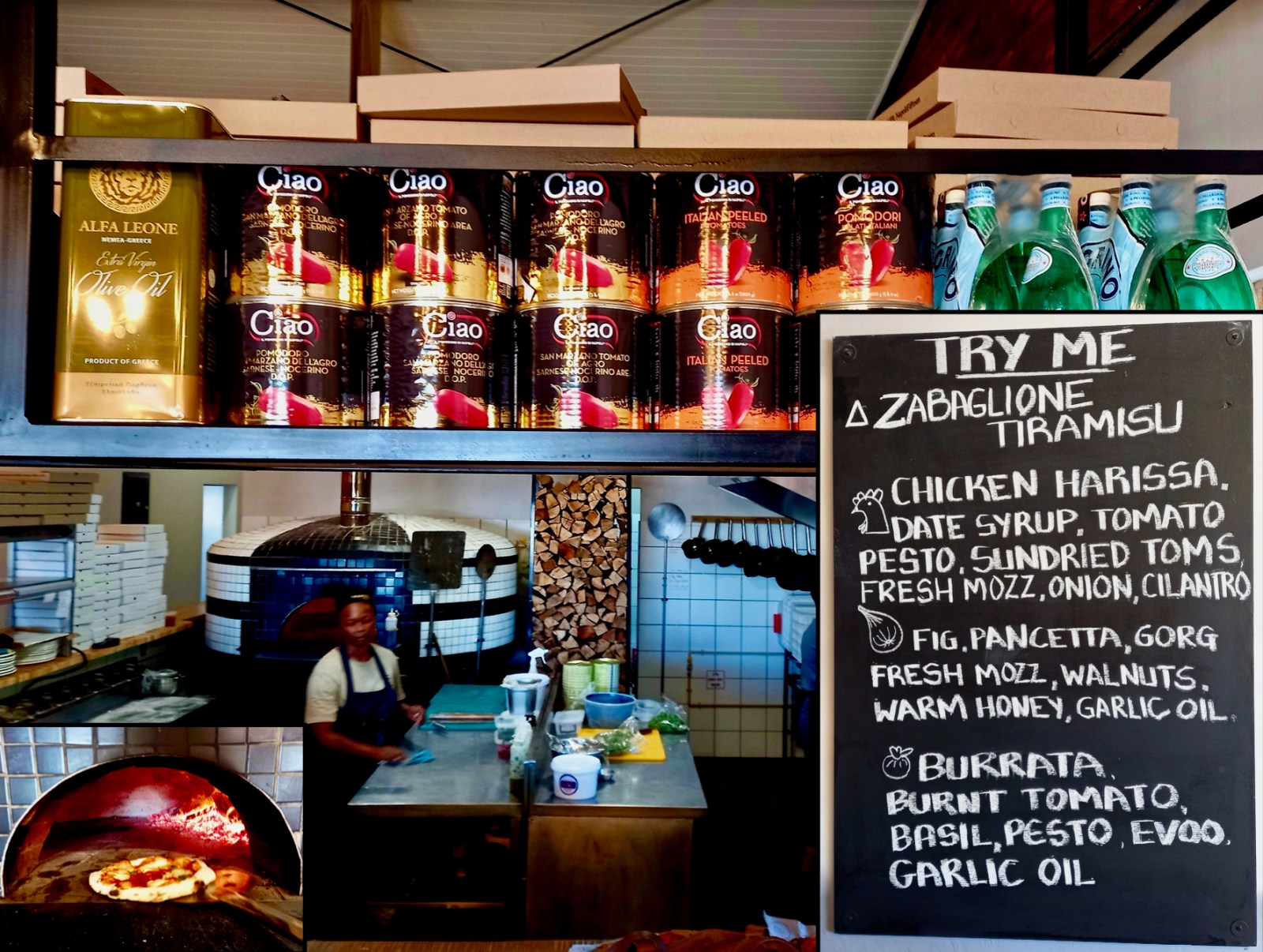
Inside Napoli Fifteen, the San Marzano tomatoes are part of the decor. Inset, taking the red-hot heat inside the wood-burning pizza oven. And chalked up, the week-I-was-there menu specials. Durban, 26 April 2024. (Photo: Wanda Hennig)
Back to the canotto-style pizza, which I read is sometimes called contemporary Neapolitan pizza. To share from Taste Atlas: Canotto is a recent style of Italian pizza characterised by its inflated rim with giant bubbles of air inside. The secret for a puffy cornicione (that rim) lies in the hydration… The dough for canotto is proofed for 48 or 72 hours, which develops the airy structure and unique aroma.
When I warm up the leftover halves of my two canotto-style pizzas in a frying pan over a gas flame in a little olive oil and butter the next night, by now at my remote cottage “writing retreat” destination (invited to stay there by friends, the owners, who are on a wild-camping trip in Patagonia), the pizza is so shamelessly tasty with its crispy, crunchy base — a tad caramelised in the heating — and the sultry truffle and coppa flavours infusing what had become an extravagantly decadent meal. I got to contemplating pizza.
Remembered a garlic pizza in Venice, so sublimely tasty that despite travelling around on a Eurorail pass at the time, sharing accommodations and on a limited budget, I ordered a second. And registering for how long pizza night at the Glenwood Bakery in Durban has been a favourite Durban go-to — that lahmajoun, an Armenian pizza with lamb mince, minted yoghurt and herb salad. Any of Adam Robinson’s pizzas.
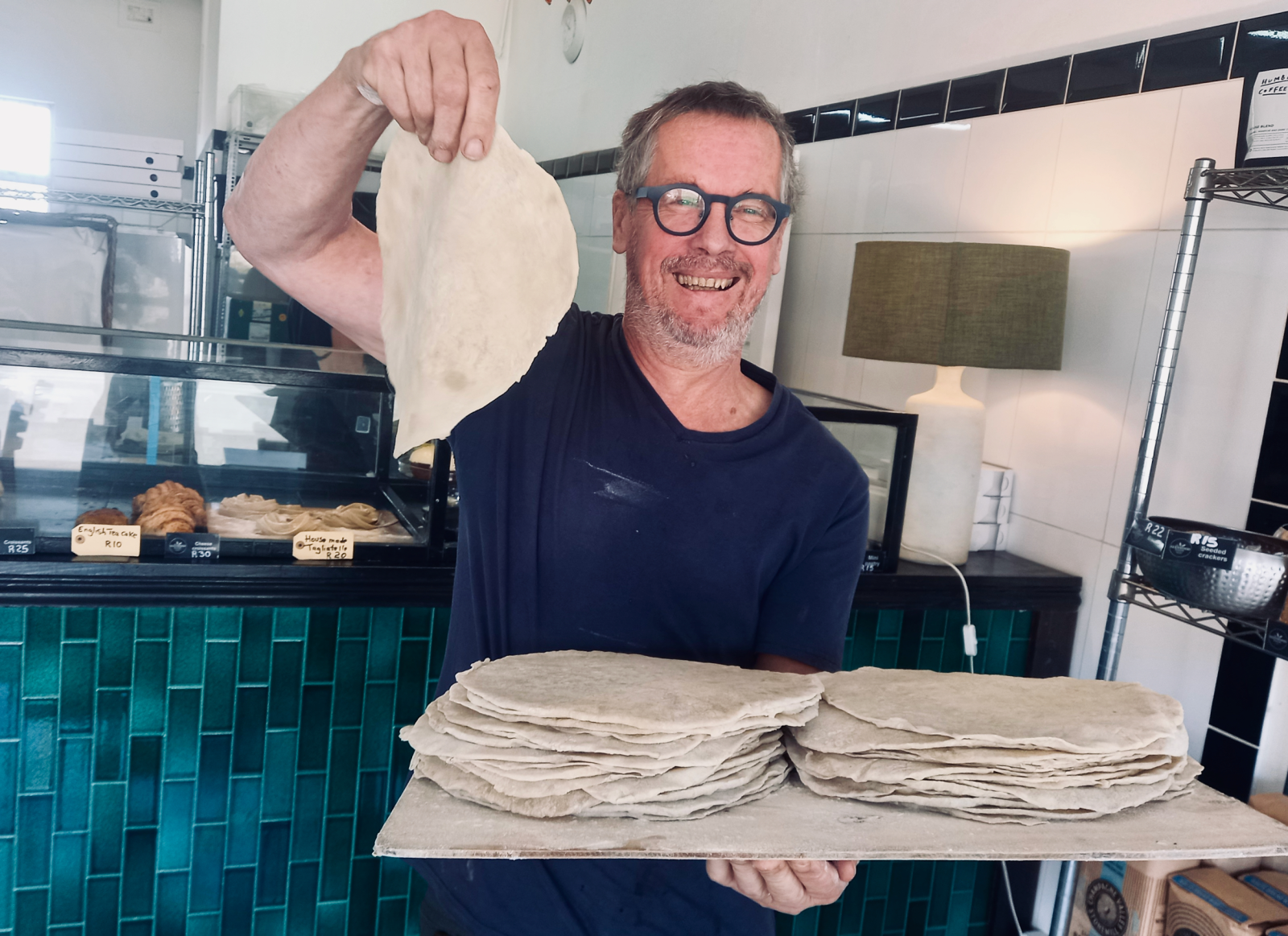
Adam Robinson at The Glenwood Bakery shows me the slow-fermented (overnight) hand-rolled par-baked pizza bases, which crisp up fast. Durban, 26 April 2024. (Photo: Wanda Hennig)
“You play with flavours. I often say to people, ‘Adam is a flavour genius’.”
I’m back in Durban, talking to chef-baker Adam Robinson at The Glenwood Bakery. “No, I’m not a genius,” he says firmly. “It’s mostly excessive reading. It’s mostly following rules and tradition. Taking ideas from tradition. I never invented anything.
“Except,” he remembers, “when I was about 25 I did steamed calves livers with soy. It was one of the most disgusting things I’ve ever eaten. So that’s when I knew where my strengths lay… and it wasn’t there.
“Look at the menu. Linguine. Tagliatelle. The pizzas. It’s all from tradition. Everything comes from somewhere else, not from me. Research the traditions. Research the ingredients. Then try. Trial and error. Pizza, the base is important. The base is the carriage. If the base is shit, you’re not going to go anywhere.”
When we featured The Glenwood Bakery in TGIFood five years ago, we called it a neighbourhood gem and one of a handful of places in Durban likely to flourish, exactly as it is, in any major city that appreciates an artisanal, uncompromising commitment to tradition and flavour. This achieved while making the tastebuds do a happy jig. Read The art of bread, aroma, flavour and passion.
Long before Durban got lucky, back in the late 1980s, Adam, who opened the Glenwood Bakery in January 2013 with his wife, Carin Robinson, was one of London’s legendary chefs. “Adam Robinson is one of the defining spirits of his age, a leading player who has shaped the gastronomy of the nineties,” to quote from Kit Chapman’s classic tome of the time, Great British Chefs. Google his name and “London chef” and see what pops up.
You ask him about any process, he will share. There are no secrets, he says, because cooking is a lot more than recipes. “So we have our pizza dough. It’s slow-fermented overnight. Bacterial fermentation for flavour and pre-digestion. It’s completely different from our bread dough. We use the same flour but different hydration (amount of water) and oil.” The bases are then hand-rolled, “why they’re so misshapen”, and par-baked.
“How did you decide on the pizza dough?”
“I don’t remember. It was about 12 years ago. We tried so many dough versions, as we did with the bagels, then chose one that felt right.”
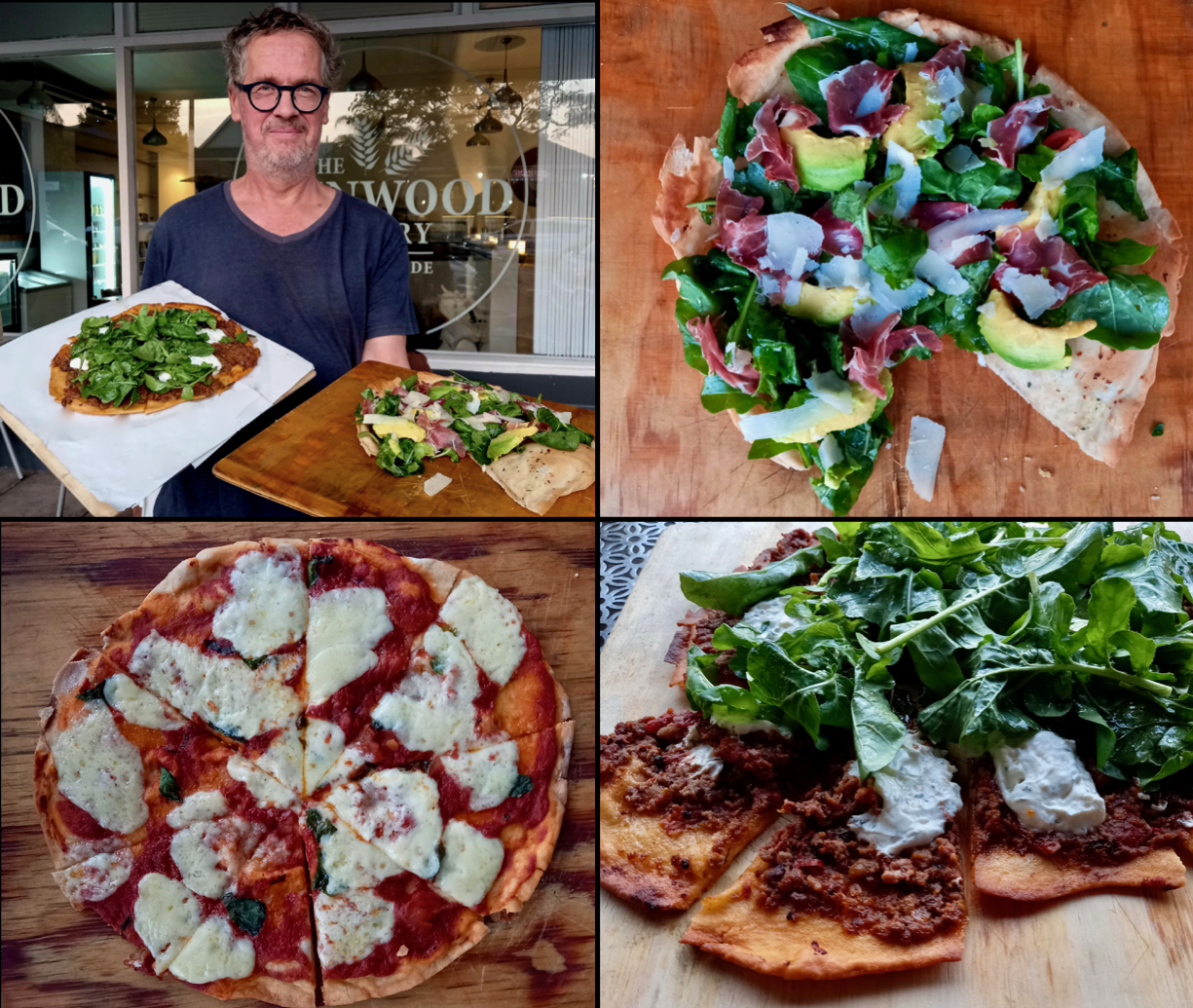
Adam Robinson at the newly opening Glenwood Bakery, Morningside café and deli, holds the lamajoun and the focaccia, served as a main. Inset, clockwise, the focaccia with Col’tempo coppa, avocado, cherry tomatoes, shaved Parmesan and rocket grown in the veggie garden outside. The lamajoun, the spiced lamb and minted yoghurt peeking from beneath the salad. And the fior di latte Margherita with anchovies. Rocket is usually added. Durban, 26 April 2024. (Photo: Wanda Hennig)
His Armenian pizza, the lahmajoun, on the pizza menu, is a staple Armenian favourite. A video a friend sent him of an immigrant Armenian shop in Tel Aviv is how it got to be a Glenwood Bakery staple and favourite. It’s now on the menu at Glenwood Bakery, Morningside, the Robinsons’ newly opened café/deli in the great little hub encompassing the Pink Duck and Ike’s Books at the bottom of Florida Road.
“They were doing this interesting-looking pizza in the video. Different from what we call American pizza. All over the Middle East, the Ottoman Empire, they do a lot of different things with flatbread, very different from the Italians. Pide, the famous baked Turkish flatbread you find on every street corner is described as a Turkish pizza, which is bullshit. It’s poor people’s food. Cheap food. It’s so interesting in that part of the world culinary-wise, the ancient bread culture. The three great cuisines of the world for me are Chinese, French and the Ottoman Empire including Greek food, Turkish food, the Caucasus: Georgia, Azerbaijan, Armenia…”
Adam experimented, trial and error, before the lahmajoun went on the menu. “Their spicing is interesting in that part of the world. They use a lot of sweet spices, cinnamon and cumin. Some paprika. Not a lot of chilli. We use a lot of cinnamon, some cumin and some ginger in the lamb. And the minted yoghurt (on the crispy base).”
On his focaccia, which arrives crisp and bubbly as a main, the coppa ham is from nearby Col’Tempo. His pomodoro (tomato) sauce for the fior di latte Margherita with anchovies and rocket (grown outside in a cultivated little garden on the street island) is those canned San Marzano tomatoes “they say from Italy but probably from Tunisia” cooked down with Parmesan rinds. “It’s a very interesting cheese, Parmesan. There’s a lot of naturally occurring MSG in Parmesan and so it does a lot of work in terms of adding flavour and savouriness, umami if you like, to sauces and things.”
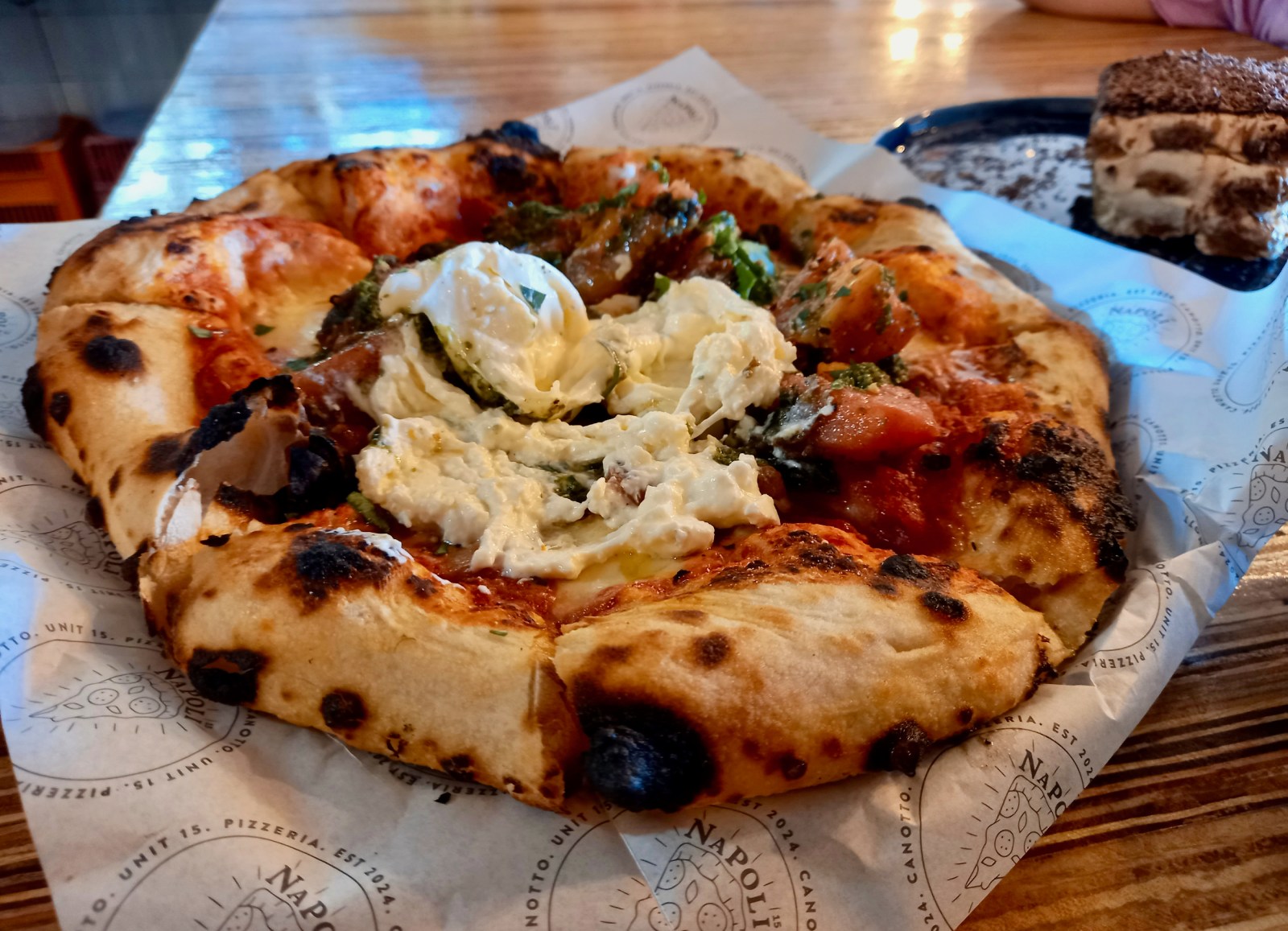
This Mark Mattinson special-menu pizza spills its ooey-gooey subtly intense mildly salty burrata flavour, to work its magic with the crispy-chewy textures of the pizza. Durban, 26 April 2024. (Photo: Wanda Hennig)
Mattinson’s pomodoro process involves squashing the San Marzano tomatoes by hand and seasoning with oregano, basil, salt — “three or four ingredients max” — and olive oil. “We put it in a casserole pot into the oven early morning, once I’ve lit the (black wattle) fire. We don’t stir it, we don’t touch it. We let it get nice and crisp around the edges. Bring it out, let it cool. Then we squash everything again with our hands. Saucy, beautiful, charred, smoky tomato.”
A quote from the Slow Food USA website: “May suitable doses of guaranteed sensual pleasure and slow, long-lasting enjoyment preserve us from the contagion of the multitude who mistake frenzy for efficiency”.
And so we get to the suddenly-fast detail of the process. The essence of the cooking of their individually hand-shaped pizzas is 90 seconds at 460°C. “The combustion of hydration, fermentation, the wetness of dough straight onto the brick creates a big bang in the oven, those lovely chars, the caramelisation, the crust and burn.”
By now I’m back to quiz Mattinson on good pizza secrets at the stylish little pizza place he recreated almost from scratch and hands-on, near Hilton’s Upper Millstone Bakery.“There’s a bit of excitement and romanticism, cooking on fire. It’s like the dawn ages. It’s a challenge, a thrill — how far can I push this? — and no room for error.”
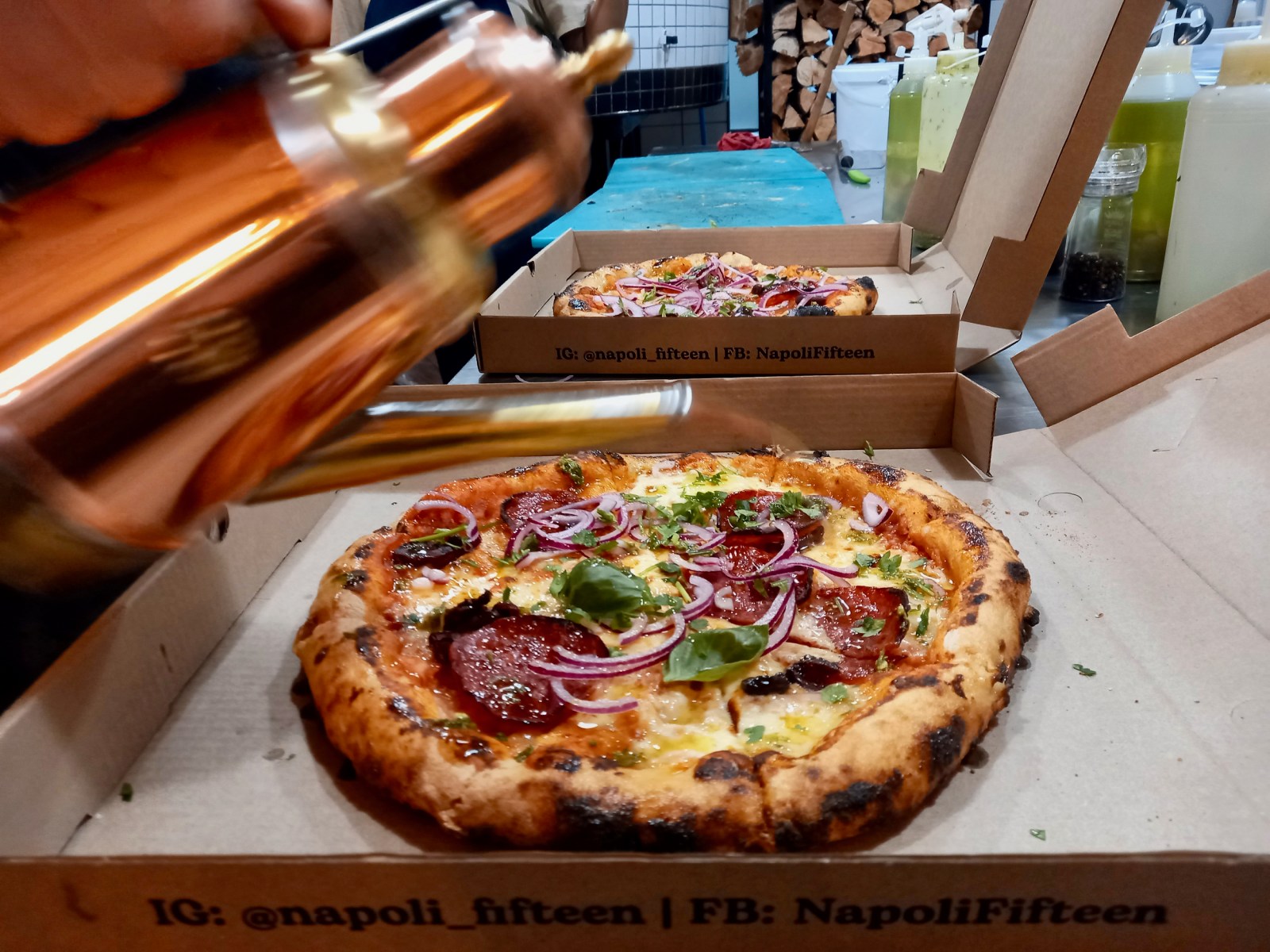
It says pepperoni on the menu, except the pepperoni at Napoli Fifteen is “gorgeous salami, 105 days cured” from Kamberg charcutier, Franco Esposito. On this pizza, with red onions, Kalamata olives, fior di latte, basil and — drizzled by Mattinson — basil oil. Durban, 26 April 2024. (Photo: Wanda Hennig)
Being a chef who knows food and ingredients, flexibility and versatility are key when it comes to the toppings. “So for example, figs, we’ve got a big window of figs in this province so I will go and buy 600 figs. They make their way onto the menu for three or four weeks, then they’re gone. That’s my intention. To see the availability, what exciting things come in that I can quickly work with. Then move on…”
You aim for authenticity. You choose the best ingredients possible. You have to include the staples people expect. They want pineapple. They want pepperoni. You can refine, adapt.
“Less is more for us here.,” he says. Simplicity. “It’s about dots of flavour on the pizza that create bursts when you eat it. So let’s say you’re eating through the fior di latte (soft Midland’s cow’s milk mozzarella), then there’s the fresh basil from Mark’s garden, then the burnt blackened tomato chunks from Maritzburg market at 4 o’ clock in the morning.”
For that pineapple, “We burn the whole pineapple in the hot coals.
“So what I try and do here is take the classic pizza everyone knows, for example your ham and mushroom, your pineapple and bacon — all of those flavours people have grown up with — and refine them. Elevate them.
“Franco’s gorgeous coppa ham from the Kamberg. Truffle oil. The infused oils I make in-house to finish the pizzas, the rosemary, sage, basil, lemon, garlic.
“The pepperoni, on the menu, is in fact Franco’s gorgeous 105 days cured salami. I tell people and they say, great, we’ll have the pepperoni. And they love it.”
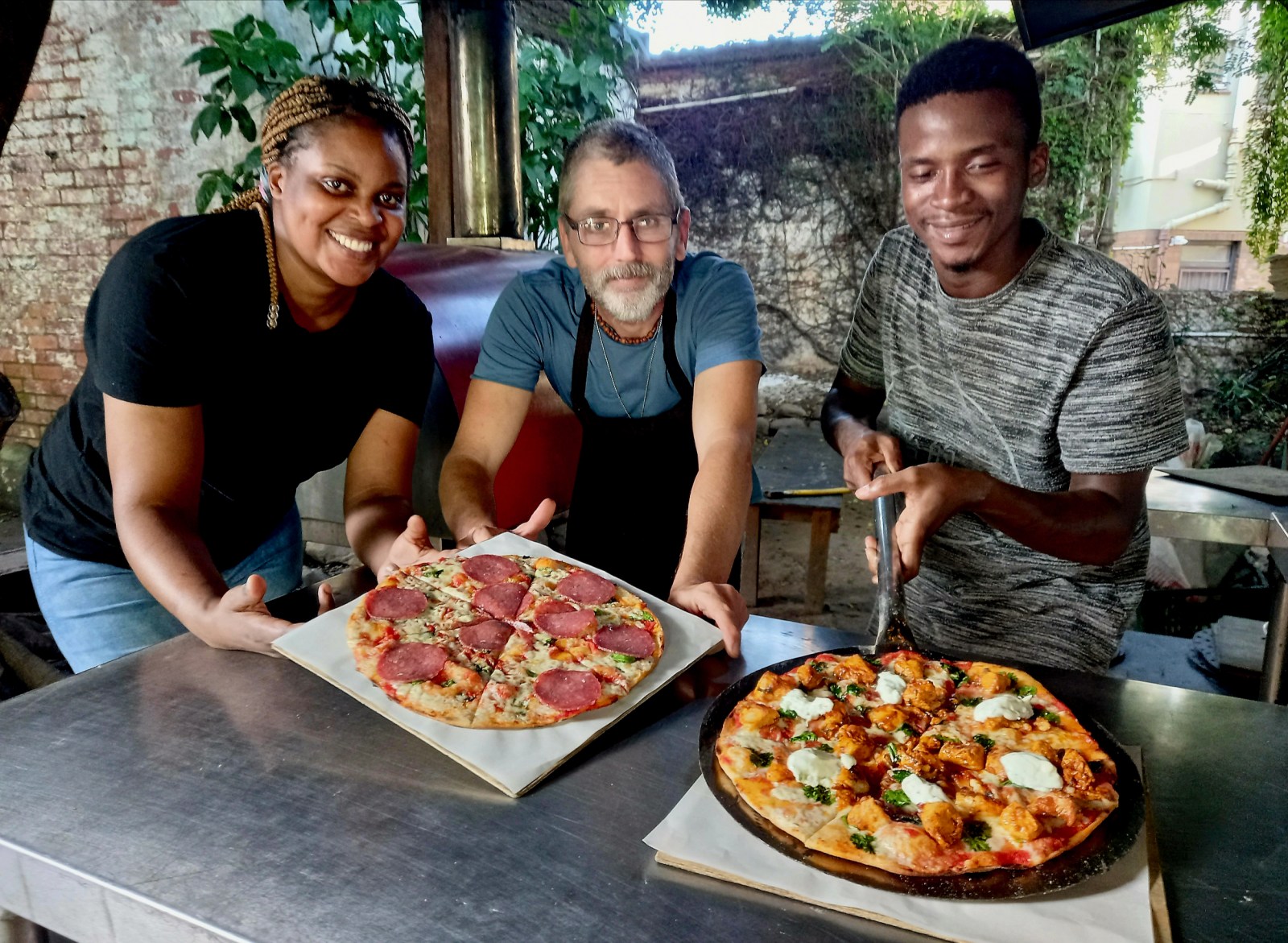
Durban’s Pizza My Heart team, from left, Lydia Dumba, Kevin Fry and Sandile Kunene with, front, their uniquely Durban tandoori di pollo with raita, the chicken chunks perfectly marinated; and their Milanesi pizza with feta and Milano salami from Col’tempo. Durban, 26 April 2024. (Photo: Wanda Hennig)
“We call ours a New York-style artisanal pizza.”
Kevin Fry got into pizza “from the sheer annoyance of bad pizzas when I was consulting”.
“I’ve never been a ‘must have a pizza’ person but I had some very good ones in London.” He mentions Ecco Pizza, which I Google and see has been making hand-made, thin-based flame-baked pizza since 2004 and is still getting decent reviews.
Pizza My Heart, at the back of an old house in Glenwood, is grungy and unprepossessing. The first time I went there, I took two friends from California. We shared the Quattro Formaggio and his Copocollo, where the coppa ham comes from Col’Tempo and the portobello mushrooms from a local supplier. The second time, a week later, a farewell dinner with a friend who was returning to New York, we followed his suggestion and had something I never thought I would order. His Arrosto di Noci, with butternut.
“I was a snob for ages,” he says. “People kept wanting butternut on a pizza and I said no. But then we tried and got it to work.” Not mushy. With the pesto, feta and Balsamic reduction and crispy base, very nice. As is his Tandoori di Pollo, marinated chunks of moist chicken from nearby Dirk’s, “a brilliant supplier,” he says. Dirk’s is a Glenwood gem, known for its community support, excellent meat and service.
Like Mattinson, Fry uses black wattle and fire. Like Robinson, his is an overnight fermentation process, if different, and he par-bakes.
Fry found food as a career by chance, in London. He went there aged 18 in 1990, anticipating a short visit. His first two jobs were making sandwiches. About 4,000 a day between 4am and 6am at the first place. Then prepping “pallets of cucumber, pallets of tuna” between 10am and 3pm at a second place.
His eyes, meanwhile, had been opened by the diversity of London’s food scene. The pheasants and rabbits hanging in butcher shop windows. He got a job as an evening busboy, which he went on to after his sandwich stint, at “a very beautiful restaurant called Odette’s at Chalk Farm”.
“Then I got hooked up with a gentleman called Dan Evans and worked in the kitchen with him first at the Brasserie and then at the Waterloo Fire Station.”
“The legendary, creative, notorious fellow-British star chef Dan Evans, who is credited with having opened London’s first “gastropub” in the 1990s,” is how we described Evans in our article on Robinson.
Fry worked in restaurant kitchens in London for six years, subsequently on cruise ships and managing culinary establishments around South Africa. So he knows his food.
It seems this is the key ingredient, what one needs to look for anytime one thinks of ordering a pizza. Is this pizzaiolo a seasoned chef? Does he understand going slow? That less is more? Does he know his food, his producers and his flavours? DM
Follow Napoli Fifteen on Instagram and on Facebook and on their website. Follow The Glenwood Bakery, Glenwood and Morningside, on Facebook, on Instagram and on their website. Follow Pizza My Heart on Facebook and on Instagram.
Follow Wanda on Instagram @wanda_hennig_new






We decided to visit the Glenwood Bakery in Glenwood for lunch and sample the pizza. Although the selection is small and the manager agreed to bringing more, like the lamb I was after. I decided on the vegan with cheese and it did not disappoint. I had goosebumps, because this pizza did not disappoint. I have never had a pizza like this and cannot wait to go back for more. I am going to drive to Hilton to try the other establish in this article. Thank you DM, for putting this gem on my radar.
Loving this white excellence!